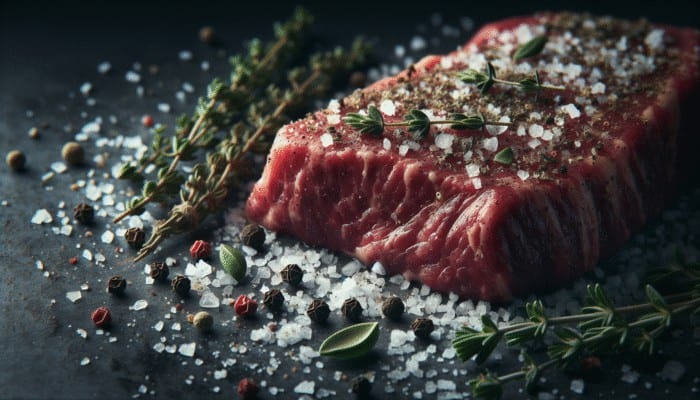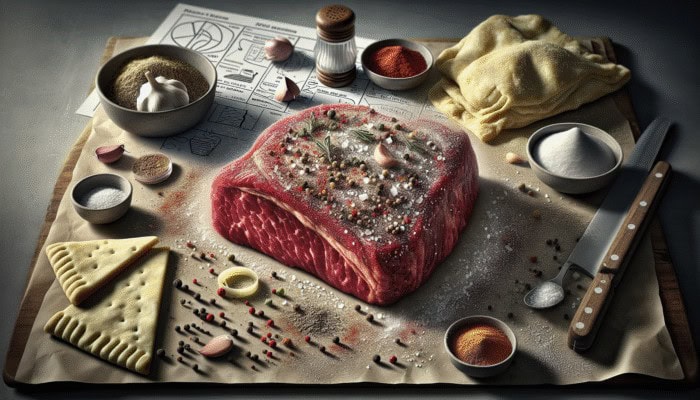Mastering the Art of Ingredient Preparation
Choosing Premium Quality Beef for Your Wellington

When embarking on the delightful journey of how to cook a classic beef wellington, selecting the right beef is crucial for success. You should opt for a tender cut such as fillet or tenderloin, as the meat's quality will significantly impact your dish's overall flavour and texture. Always prioritise freshness; look for bright red meat with a fine grain free from excessive marbling. Properly trimmed beef not only enhances presentation but also ensures even cooking. Cultivating a relationship with your local butcher can lead to discovering superior quality cuts, so feel free to ask for recommendations or advice on the best options available.
Once you have procured your prime cut of beef, consider its source. Grass-fed beef is renowned for its rich flavour and leanness, which can elevate your Wellington to new heights. Alternatively, if you're feeling adventurous, explore unique global options, such as Wagyu or Kobe beef, famous for their exquisite marbling and tenderness. Choosing these options can transform beef Wellington into a culinary experience that rivals gourmet restaurants worldwide.
Crafting the Perfect Duxelles for Enhanced Flavour
Duxelles, a finely chopped mixture of mushrooms, is the cornerstone of the beef wellington, playing an essential role in enhancing the dish's overall flavour profile. Begin by selecting a mix of mushrooms, as their diversity can significantly influence the taste. Popular options include cremini, shiitake, or button mushrooms. Finely chop them with shallots and garlic, then sauté everything in a hot pan with a splash of olive oil for a fragrant base.
The secret to achieving the perfect duxelles lies in cooking out the moisture. As the mushrooms sauté, they release water; continue cooking until this liquid evaporates and the mixture thickens into a rich paste. This concentrated flavour is a barrier, preventing the pastry from becoming soggy while infusing the beef with an unforgettable umami punch that enhances every bite. For an added gourmet touch, consider incorporating a splash of white wine or a sprinkle of truffle oil to elevate the earthy tones of the mushrooms.
Creating the Pastry Base for Your Wellington
The pastry transforms your beef Wellington into a stunning culinary masterpiece. Puff pastry is the ideal choice, celebrated for its flaky, buttery texture that contrasts beautifully with the beef and duxelles. If you're using frozen pastry, ensure it’s adequately thawed in the fridge before rolling it out to maintain its integrity during preparation.
Aim for an even thickness of about 3mm when rolling out your pastry. This uniform thickness ensures it cooks evenly, producing a crisp exterior. Dust your work surface with flour to prevent sticking, and consider cutting the pastry into a rectangle that will comfortably encase your beef. Remember, a well-prepared pastry lays the foundation for the entire dish, so take your time to perfect this crucial step.
Enhancing the Beef with Seasoning Techniques

Now that your beef is ready, it’s time to elevate its natural flavours through effective seasoning techniques. Generously sprinkle sea salt and freshly cracked black pepper over the entire surface of the meat. This step is vital as it enhances the beef's flavour and creates a delicious crust once seared, amplifying its taste.
Consider incorporating finely chopped herbs like thyme or rosemary into the seasoning mix for those wishing to add an aromatic touch. These herbs provide a fragrant backdrop and infuse the beef with a depth of flavour that perfectly complements the earthy notes of the duxelles. Allow the seasoned meat to sit at room temperature for about 30 minutes before cooking; this resting period helps the flavours penetrate the meat and ensures even cooking.
Efficiently Assembling Your Beef Wellington
Having prepared all components, it’s time to assemble your beef wellington. Start with a clean work surface, laying down the rolled-out pastry. Spread an even layer of duxelles over the pastry, ensuring it covers the entire surface. This not only adds flavour but also serves as a crucial moisture barrier.
Next, carefully position your seasoned beef fillet in the centre of the duxelles-covered pastry. The key to a successful assembly is securely wrapping the beef while avoiding air pockets, which can lead to leaks during baking. Fold the pastry over the beef, tucking in the ends to create a neat, sealed package. This meticulous process ensures that your Wellington maintains its shape during baking and that every bite is infused with the sumptuous flavours you have created.
Cooking Techniques for the Perfect Beef Wellington
Perfecting the Seasoning of the Meat

The seasoning process is often overlooked but serves as the cornerstone of flavour in how to cook a classic beef wellington. After generously seasoning with salt and pepper, allow your beef fillet to rest for about 30 minutes. This resting phase enhances the flavour and allows the meat to come to room temperature, ensuring that it cooks evenly throughout.
Consider this: a well-seasoned piece of meat will burst with flavour, contrasting beautifully with the rich duxelles and flaky pastry. You might sprinkle some paprika or garlic powder over the beef for an added touch. These additional spices will enhance the overall flavour profile and contribute to a deeper, richer taste experience.
Achieving the Perfect Sear on the Beef
Searing is where the magic truly happens. Heat a skillet over high heat, adding a drizzle of oil until it shimmers enticingly. Place your seasoned beef in the pan, allowing it to sear undisturbed for approximately 2-3 minutes on each side. The goal is to create a beautiful, golden crust that locks in the juices while providing a delightful textural contrast once baked.
Keep a close eye on your beef; you want to sear the outside without cooking the inside past medium-rare. Remember, the beef will continue to cook during the baking process, so it’s crucial to achieve that perfect crust without compromising the meat's integrity. Once seared, transfer the beef to a plate and let it rest for at least 10 minutes. This resting phase is essential, allowing the juices to redistribute and ensuring a succulent slice when you finally cut into your Wellington.
Essential Steps for Resting the Beef
Resting your beef after searing is a crucial step that should not be overlooked if you want to master how to cook a classic beef wellington. Allowing the meat to rest for a minimum of 10 minutes ensures that the juices remain within the fillet. If you slice into the meat too soon, those precious juices will run out, leaving you with a dry piece of beef that doesn't do justice to your hard work.
While resting, loosely cover the beef with foil to keep it warm. This step preserves heat and gives the beef time to relax, making it easier to slice later. Consider this an opportunity to tidy up your workspace and prepare for the final assembly of your Wellington. Good food deserves patience, and this is the moment where your beef transforms from a mere ingredient into the star of your culinary masterpiece.
Efficiently Assembling the Wellington
Layering the Components for Maximum Impact
Now that your beef has rested, it’s time to combine all the elements and create an exquisite beef Wellington. Start by laying your prepared pastry on a clean, flat surface. The first step is to spread the duxelles evenly over the pastry, ensuring every corner is covered. This layer acts as a flavour enhancer and a barrier to protect the pastry from moisture during baking.
Once the duxelles are laid out, position the beef fillet snugly in the centre of the pastry. It’s important to keep the beef in place to retain its shape and maintain an even bake. With the beef positioned, gently fold the pastry over the top, tucking it tightly. Use your fingers to press out air pockets, and ensure the edges are securely sealed. This meticulous assembly process is key to delivering a well-cooked, beautifully presented beef Wellington.
Cut off any excess pastry and use a sharp knife to create a decorative pattern on the top. This adds an artistic touch and allows steam to escape during baking, preventing sogginess. Remember, presentation is just as important as taste, and a well-assembled Wellington speaks volumes about your culinary skills.
Expert Tips for Wrapping the Beef
Wrapping your beef securely is a vital part of the assembly process. Once the duxelles is spread and the beef is placed, carefully fold the edges of the pastry over the meat. The aim is to create a snug fit around the beef, ensuring no part is left exposed to the oven’s heat. This prevents moisture from escaping, helping you achieve that perfectly tender beef nestled inside a flaky exterior.
Moisten the edges of the pastry with a bit of water to help seal them together. This step is crucial; if the edges aren’t sealed adequately, the juices from the beef and duxelles may leak out, leading to a soggy pastry. Once the beef is tightly wrapped, flip the entire package seam-side down onto a baking tray lined with parchment paper. This ensures the seam is hidden and allows the pastry to bake evenly from the bottom up.
Rushing this process risks compromising the final product. Take your time to achieve a well-wrapped beef wellington that will make every bite a delightful texture and flavour experience.
The Importance of Egg Washing the Pastry
An egg wash is your secret weapon for achieving a stunning golden-brown finish on your beef wellington. Whisk together an egg with a splash of water or milk to create a smooth mixture. Use a pastry brush to apply this wash generously over the entire surface of the wrapped pastry, ensuring every inch is covered.
This gives Wellington its beautiful sheen and helps prevent the pastry from separating during baking. The egg wash is crucial in achieving that eye-catching, glossy appearance that transforms your Wellington from a meal into a centrepiece on the dining table.
For an extra touch of finesse, consider sprinkling some sea salt or sesame seeds over the top just before baking. This will add another layer of flavour and texture, elevating your dish from ordinary to extraordinary. Remember, the aesthetic appeal is as important as taste for impressive dishes like a classic beef wellington.
Baking Your Wellington to Perfection
Essential Steps for Preheating the Oven
Proper oven temperature is essential for achieving the perfect beef Wellington. Preheat your oven to 200°C (390°F) to ensure the pastry puffs up beautifully and the meat cooks evenly. This high temperature makes the outside crisp while ensuring the inside reaches the perfect doneness.
Before you place your Wellington in the oven, let it rest at room temperature for about 15 minutes. This practice helps prevent thermal shock, which can lead to uneven cooking. A well-prepped oven will result in a beautifully baked pastry that’s both golden and flaky, maintaining the integrity of the filling inside.
Use an oven thermometer if you have one, as oven temperatures can vary. Ensuring that your oven is at the correct temperature before baking is fundamental to mastering cooking a classic beef wellington.
Strategies for Monitoring the Temperature
A meat thermometer is a game-changer for achieving the ideal level of doneness for your beef Wellington. Insert the thermometer into the thickest part of the beef, ensuring it doesn’t touch the pastry. Aim for an internal temperature of around 52°C (125°F) for medium-rare. Once out of the oven, the residual heat will continue cooking the beef, bringing it to the perfect finish.
Monitoring the internal temperature is crucial, as overcooking will lead to a dry, less enjoyable meal. Keep a close eye on the time as well; typically, your Wellington will need about 25-30 minutes in the oven, but every oven is different. Once your beef wellington reaches the desired temperature, remove it from the oven and let it rest for 10-15 minutes before slicing. This ensures that all those delicious juices are retained, resulting in tender, juicy slices when you cut into them.
Achieving the Ideal Bake for Your Wellington
When your beef Wellington emerges from the oven, it should be a sight to behold—a stunning golden-brown crust with beautifully puffed pastry. The perfect bake is all about timing and temperature. Monitor the pastry closely during the last few minutes; if it’s browning too quickly, consider covering it loosely with foil to prevent burning while allowing the beef to reach the perfect temperature.
A successful bake means the pastry will be flaky, crisp, and light, complementing the rich beef and duxelles. Give it a gentle prod to check for doneness; if it feels firm yet slightly yielding, you’re right on track.
Once baked, remember that patience is key. Allow your beef wellington to rest before slicing, ensuring that every piece celebrates textures and flavours that will impress any dinner guest when you serve it.
Techniques for Resting and Slicing the Wellington
Importance of Allowing Rest Time
Resting your beef wellington after baking is crucial to ensuring a juicy and flavourful dining experience. As tempting as it is to dive right in, the resting period allows the juices to redistribute throughout the meat, creating incredibly tender and succulent slices.
Allow your Wellington to rest for 10-15 minutes before slicing it. This brief wait can make all the difference in maintaining moisture levels and preventing dryness. While resting, keep it covered with a clean kitchen towel or foil to retain warmth. This period is also an ideal time to prepare your side dishes or finish up any garnishes to elevate your presentation.
The anticipation of slicing into your Wellington is part of the culinary journey. Each moment spent waiting only enhances the reward of a beautifully cooked meal, deserving of every compliment it will receive from your guests.
Expert Slicing Techniques for Presentation
When it comes time to slice your beef wellington, having the right technique is essential for showcasing its stunning layers. Start with a sharp knife; a serrated knife works well to maintain the integrity of the pastry while cutting through the beef and duxelles layers smoothly.
Begin by cutting off the ends to create a clean edge, then proceed to slice the Wellington into even pieces, about 2-3 cm thick. This thickness ensures that each portion includes a generous amount of juicy beef and rich mushroom duxelles, all wrapped in flaky pastry.
Present your slices on a warm plate, allowing the beautiful layers of your Wellington to shine. This thoughtful presentation will impress your guests and heighten their anticipation for the delightful flavours that await them.
Curating Complementary Serving Suggestions
Pairing your beef wellington with complementary sides can elevate your dish from extraordinary to unforgettable. Classic accompaniments include roasted seasonal vegetables, such as Brussels sprouts or carrots, which add colour and freshness to your plate.
Consider serving it alongside creamy mashed potatoes or a rich potato gratin, which beautifully complements the beef's flavours. A vibrant sauce, such as a red wine reduction or a rich gravy, can also add another layer of flavour, enhancing the experience of every bite.
Remember to consider wine pairings; a robust red, such as a Cabernet Sauvignon or a full-bodied Merlot, can elevate your meal further and provide an excellent balance to the rich flavours of the beef Wellington. Remember, the goal is to create a harmonious dining experience that captivates the senses and leaves a lasting impression on your guests.
Exploring Variations and Additions for Your Wellington
Enhancing Flavour with Prosciutto
Consider wrapping your beef in prosciutto before adding the duxelles for an extra layer of flavour and moisture. This addition not only enhances the dish's savoury profile but also helps keep the beef moist during cooking. The prosciutto’s saltiness complements the beef beautifully, creating a harmonious blend of flavours that enhances the overall experience.
When using prosciutto, lay the slices in slightly overlapping rows to form a complete layer. Once the beef is wrapped, add the duxelles and pastry as usual. The result is a decadent beef wellington that tantalises the taste buds and impresses even the most discerning palates.
Incorporating Fresh Herbs for Extra Aroma
Elevate your duxelles by incorporating fresh herbs, such as thyme or rosemary, during cooking. These aromatic herbs will infuse the mushroom mixture with a fragrant, earthy quality that enhances the overall flavour of your beef wellington.
Chop the herbs and add them to the mushroom mixture as it cooks. Not only do they add flavour, but they also create a visually appealing touch. This small, impactful change can turn a classic dish into a gourmet masterpiece, showcasing your creativity and culinary flair.
Personalising Your Wellington with Unique Fillings
Feel free to personalise your beef wellington by experimenting with different fillings. For instance, adding sautéed spinach or a layer of creamy cheese can create a delightful twist on the traditional recipe. Each of these options not only changes the flavour profile but also adds texture to the dish.
Consider incorporating roasted red peppers or a layer of pâté for a luxurious touch. These variations allow you to cater to different taste preferences while keeping the essence of the classic dish intact. The beauty of cooking lies in its adaptability, and your Wellington can be a canvas for your culinary creativity.
Exploring Different Meats for Your Wellington
While beef is the traditional choice for a Wellington, you can certainly experiment with other meats. Veal or pork tenderloin can be excellent alternatives, bringing unique flavours and textures.
When using different meats, adjust the cooking times accordingly, as they may require different levels of doneness. This experimentation allows you to create a diverse range of beef wellingtons that can cater to different tastes and occasions, proving that the classic dish can be versatile and exciting for any culinary enthusiast.
Avoiding Common Mistakes for a Flawless Wellington
Avoiding Overcooking the Beef
One of the most common mistakes in mastering the cooking of a classic beef Wellington is overcooking the beef. Since the beef fillet will continue to cook while it rests after baking, removing it from the oven at the right temperature is essential.
Utilise a meat thermometer to check the internal temperature, aiming for medium-rare doneness at around 52°C (125°F). The golden rule is to pull the beef from the oven while it still has some residual warmth; this ensures a perfectly juicy centre when you finally slice into the Wellington, rewarding your efforts with a delightful dining experience.
Preventing a Soggy Pastry Base
A soggy bottom can ruin the delight of a beef Wellington. To avoid this, ensure that the duxelles are thoroughly cooked and moisture-free before spreading them on the pastry.
Additionally, allowing the beef to cool slightly before wrapping it in pastry can help minimise moisture. Finally, a well-preheated oven is vital for achieving that crispy, flaky exterior that contrasts delightfully with the tender beef inside, making your Wellington an unforgettable dish.
Ensuring Sufficient Seasoning for Maximum Flavour
Without proper seasoning, your beef wellington may fall flat. Generously season the beef with salt and pepper, and don’t skimp on flavourings in the duxelles. Adding fresh herbs can elevate the dish and create a beautifully balanced flavour profile that keeps diners returning for more.
Taste the duxelles before assembling; it should be rich and savoury, perfectly complementing the beef. Ensuring that every component is well-seasoned will create a well-rounded dish that is memorable and satisfying for your guests.
Frequently Asked Questions
Can I prepare beef Wellington ahead of time?
Yes, you can prepare the components ahead of time. Assemble the Wellington without baking it, then refrigerate it until you're ready to bake it. Just ensure it's well wrapped to prevent moisture from affecting the pastry.
What is the best cut of beef for a wellington?
The best cut for a classic beef wellington is beef fillet or tenderloin. These cuts are tender, resulting in a succulent dish that melts in your mouth.
Can I use other types of mushrooms in the duxelles?
Absolutely! Feel free to experiment with mushrooms like shiitake, oyster, or wild. Each type will bring a unique flavour to your duxelles, enhancing the overall experience.
How do I know when the beef is cooked to my liking?
Use a meat thermometer to check the internal temperature. For medium-rare, aim for around 52°C (125°F) before resting; this will yield a perfect piece of meat once sliced.
What should I serve with beef Wellington?
Consider serving your beef Wellington with roasted vegetables, creamy mashed potatoes, or a rich red wine sauce to complement the dish beautifully and enhance its overall appeal.
Can I freeze beef Wellington?
Yes, you can freeze an unbaked beef wellington. Wrap it tightly in plastic wrap and foil, then bake from frozen, adding extra time to the cooking process to ensure it is thoroughly cooked.
What’s the best way to reheat leftover beef Wellington?
To reheat, place it in a preheated oven at a low temperature until warmed through. Avoid microwaving, as this can make the pastry soggy and less enjoyable.
Is it necessary to use an egg wash?
While not strictly necessary, using an egg wash gives the pastry a beautiful golden sheen and helps seal the edges, making it visually appealing and enhancing its overall texture.
Can I use a different pastry for the Wellington?
Puff pastry is traditional, but you can experiment with shortcrust pastry for a different texture. Just remember that the baking time may vary, depending on the type of pastry used.
How can I prevent the pastry from becoming soggy?
Ensure the duxelles are fully cooked and moisture-free before spreading them on the pastry. Wrapping the beef tightly and baking at the correct temperature also helps create a crispy exterior.



Your insights into selecting the perfect cut of beef for a Wellington are spot on. I remember my first attempt at making one; I didn’t realize how much the quality of the beef could influence the final dish. I chose a lesser cut in a rush, and while the Wellington was still tasty, it certainly lacked the depth that a tenderloin would have given.
It’s interesting how the choice of beef can really transform a dish like Wellington, isn’t it? I had a similar experience on my first try. I rushed into the kitchen with enthusiasm but didn’t fully appreciate how crucial that tenderloin was for the overall flavor and texture. It’s a bit of a lesson in patience, realizing that sometimes the best results come from taking the time to select quality ingredients.
Speaking of quality ingredients, if you’re looking to elevate your burger game for Memorial Day, I found some great recipes that really showcase how the right choices can make all the difference.
‘Best Memorial Day Burger Recipes: A Festive Guide’
https://cookinggods.com/best-memorial-day-burger-recipes-a-festive-guide/.
It’s interesting to hear about your first experience with beef Wellington. Choosing the right cut really makes a world of difference, doesn’t it? When you think about it, the tenderloin isn’t just about being a premium option; it brings that buttery texture that pairs so well with the rich flavors of the mushroom duxelles and the puff pastry.
Ah, the rush to dinner success—it can lead us down some interesting paths. Your experience definitely highlights a key lesson in the kitchen: sometimes good things are worth waiting for. It’s like dating; if you pick the wrong partner, the night might still be fun, but you won’t be swooning.
“I’m glad to hear you found value in the tips! If you’re looking to elevate your next Wellington, check out this resource for selecting top-quality beef cuts.”
https://cookinggods.com/DigestiveHealth